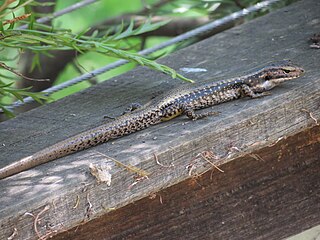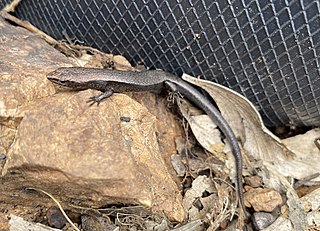
Skinks are lizards belonging to the family Scincidae, a family in the infraorder Scincomorpha. With more than 1,500 described species across 100 different taxonomic genera, the family Scincidae is one of the most diverse families of lizards. Skinks are characterized by their smaller legs in comparison to typical lizards and are found in different habitats except arctic and subarctic regions.

Eulamprus is a genus of lizards, commonly known as water skinks, in the subfamily Sphenomorphinae of the family Scincidae. The genus is native to Australia.

Lampropholis is a genus of skinks, commonly known as sunskinks, in the lizard subfamily Eugongylinae of the family Scincidae. The genus Lampropholis was previously found to belong to a clade with the genera Niveoscincus, Leiolopisma and others of the Eugongylus group within Lygosominae. All species of Lampropholis are endemic to Australia. For similar skinks see genera Bassiana, Pseudemoia, and Niveoscincus.

Carinascincus is a genus of skinks, commonly called snow skinks or cool-skinks and residing mainly in Tasmania or Victoria, Australia. Then recognised as the genus Niveoscincus, it was found to belong to a clade with the genera Carlia, Lampropholis and others of the Eugongylus group within Lygosominae. Cogger has rejected the use of the junior name Niveoscincus and recognizes the valid senior generic name Carinascincus for the group. For similar skinks see genera Pseudemoia, Lampropholis, and Bassiana. These skinks have adapted to the cooler weather of southern Australia and particularly Tasmania, hence the common names.

In animals, viviparity is development of the embryo inside the body of the mother, with the maternal circulation providing for the metabolic needs of the embryo's development, until the mother gives birth to a fully or partially developed juvenile that is at least metabolically independent. This is opposed to oviparity, where the embryos develop independently outside the mother in eggs until they are developed enough to break out as hatchlings; and ovoviviparity, where the embryos are developed in eggs that remain carried inside the mother's body until the hatchlings emerge from the mother as juveniles, similar to a live birth.

Placentation is the formation, type and structure, or arrangement of the placenta. The function of placentation is to transfer nutrients, respiratory gases, and water from maternal tissue to a growing embryo, and in some instances to remove waste from the embryo. Placentation is best known in live-bearing mammals (Theria), but also occurs in some fish, reptiles, amphibians, a diversity of invertebrates, and flowering plants. In vertebrates, placentas have evolved more than 100 times independently, with the majority of these instances occurring in squamate reptiles.
Carinascincus palfreymani, known commonly as the Pedra Branca skink, as well as the Palfreyman's window-eyed skink, the Pedra Branca cool-skink, or the red-throated skink, is a species of skink in the family Scincidae. The species is endemic to Australia, and is restricted to the windswept Pedra Branca, an island off southern Tasmania of only 2.5 ha, where it is dependent on the seabird colonies. It is the only lizard species found on the island.

Carinascincus metallicus, the metallic cool-skink or metallic skink is a species of skink in the family Scincidae. It is endemic to Australia, found in southern Victoria, as well as in Tasmania where it is the most widespread and common lizard, occurring on many offshore islands in Bass Strait as well as the mainland. It gives birth to live young. It is highly variable in colour and pattern, and may be a complex of closely related species.

The southern water skink, cool-temperate water-skink, highland water skink, or Dreeite water skink is a medium-sized species of skink that is endemic to Australia. These skinks are found in New South Wales, South Australia, Victoria as well as on Tasmania's Rodondo Island in the Bass Strait. They are viviparous, mating in spring, and giving birth to live young in mid to late summer.

Pseudemoia entrecasteauxii, also known commonly as Entrecasteaux's skink, the southern grass skink, the tussock cool-skink, and the tussock skink, is a species of lizard in the family Scincidae. The species is endemic to Australia.

Anepischetosia maccoyi, also known commonly as the highlands forest-skink, highlands forest skink, Maccoy's elf skink, or McCoy's skink, is a species of lizard in the family Scincidae. It is the only species in the monotypic genus Anepischetosia, and is endemic to Australia.
The southwestern cool-skink is a species of skink.
The red-tailed soil-crevice skink, also known commonly as Kinghorn's grassland striped skink and Kinghorn's snake-eyed skink, is a species of skink, a lizard in the subfamily Eugongylinae of the family Scincidae. The species is endemic to Australia.

Carinascincus coventryi, also known commonly as Coventry's window-eyed skink and the southern forest cool-skink, is a species of lizard in the family Scincidae. The species is endemic to Australia.
The alpine cool-skink, also known commonly as the northern snow skink, is a species of lizard in the family Scincidae. The species is endemic to Tasmania in Australia.

Pseudemoia baudini, also known commonly as Baudin's skink, Baudin's window-eyed skink, and the Bight Coast skink, is a species of lizard in the family Scincidae. The species is endemic to Australia.
Pseudemoia cryodroma, also known commonly as the alpine bog skink, is a species of lizard in the family Scincidae. The species is endemic to Victoria in Australia.

Pseudemoia pagenstecheri, also known commonly as the southern grass tussock skink or the southern tussock grass skink, is a species of lizard in the family Scincidae. The species is endemic to Australia.

Pseudemoia rawlinsoni, also commonly known as the glossy grass skink and Rawlinson's window-eyed skink, is a species of lizard in the family Scincidae. The species is endemic to Australia.
Pseudemoia spenceri, also known commonly as Spencer's widow-eyed skink or the trunk-climbing cool-skink, is a species of lizard in the family Scincidae. The species is endemic to Australia.














